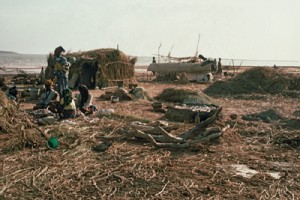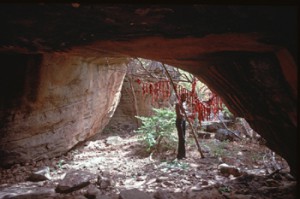Introduction
Recent discoveries at Ounjougou reveal that Africa has experienced one of the most ancient ceramics in the world, at the beginning of the 10th millennium BC, while recent researches in the Sahara and in the Nile Valley demonstrate the practice of domestication of bovines in the course of the 9th millennium BC, more than 1000 years before Greece and the Middle East.
Use of the term “Neolithic” in Africa: two schools of thought
For Europe and the Near East, the term “Neolithic” designates sedentary societies whose economy is based on a system of production of food-producing goods. Apart from a few rare exceptions, the Neolithic is characterized here by the adoption, in varying order, of animal domestication, agriculture, ceramic production and sedentation. At some point later on, this process ended, for cereal-growing societies, with urbanization.
In Africa, by contrast, the process of “Neolithization” is unclear. Its acceptance by researchers varies according to region or even human groups, and the uneven quality of research does not aid in understanding. So, we observe that the same site may be considered, depending on the author, to be Neolithic, Proto-Neolithic, Meso-Neolithic, Epipalaeolithic or Final Palaeolithic! This lack of terminological coherence makes overall understanding of the processes difficult.
Considering all the data, two opposing currents of thought exist: one gives priority to the material culture, the other to a range of economic activities. In the first view, material assemblages prior to the advent of metallurgy are determined to be Neolithic or not on the basis of the presence of absence of pottery. This approach has the merit of being practical, but in its brutal simplicity, does not take into account the economic distinctiveness of diverse societies.
In the second view, the term Neolithic is employed only to designate cultures prior to the age of metals for which archaeologists can demonstrate the existence of a true production economy. This approach thus concurs with the model for the Near East and Europe, which, in comparison with the approach based on the presence of pottery, is more satisfying since the economic characteristics of the societies are taken into account. However, this approach most often excludes the Neolithic from Africa, because in practice, the organic remains of the different production systems are so poorly preserved in the Sub-Saharan tropical acidic iron-rich soils that it is impossible to find evidence for the practice of animal husbandry or agriculture. We can, certainly, return to other evidence, such as rock art to identify animal husbandry, or low stone walls to infer the use of farming perimeters, but their dating is often difficult and their interpretation ambiguous. The presence of silos and grinding materials could as easily be associated with the management of wild grains as with domesticated cereals.
Apart from these difficulties, we think – mainly because it is still in part the case today – that Africa developed societies with very different economies, for which the mechanisms cannot be compared to those – European or Near Eastern – used as references. It is rare to find, before the Iron Age, African societies that warrant the qualification “Neolithic” in its European sense, that is to say, sedentary populations jointly including animal husbandry, agriculture and pottery.
The “African Neolithic”: considerations and proposal
For all that, to refuse Neolithization to Sub-Saharan societies is Eurocentric and dangerous. Once simplified and removed from its context, this idea opens the way to political appropriation and a frequently disparaging direction characterized by remarks about Africa of the style: the “continent that discovered neither the wheel, nor writing nor the Neolithic”, etc. This is not only detestable, but we have seen, very much false.
So how to approach Neolithization in Africa? Without raising controversy or losing ourselves in a debate that has dragged on for decades, we defend three ideas, in our view essential to characterize the African Neolithic by what it is proper to it :
- The first idea is that pottery-making societies that appeared in Africa from the beginning of the Holocene can be considered Neolithic, or at least proto-Neolithic, even if the sedentary way of life or the domestication of plants and animals were not concurrently practiced. We emphasize that the creative shaping of clay and its firing evidence a type of influence of humans on the environment entirely different from hunter-gatherer societies. A similar invention could only have repercussions on the social division of labor and knowledge, with respect to the technical information needed to recognize the quality of clays and tempers, firing parameters and shaping techniques. Such a practice is also incompatible with the high degree of mobility of hunter-gatherers, given that clay sources are stationary and that the pottery made is fragile and heavy! So, the first cultures with pottery were societies which, to produce, have domesticated natural elements such as clay, plants or animals. The transformation or domestication of natural elements in order to produce, is this not the essence of Neolithization?
- The second idea is that the attributes of the African Neolithic system are the same as those in Europe – agriculture, animal husbandry, pottery, sedentation -, but, instead of being necessarily present simultaneously within a single population, could exist at the same time in several contemporaneous groups. Without this flexibility in the application of the traditional definition of the Neolithic, we risk concluding that no African society at the beginning of the Holocene could have been Neolithic. In fact, a number of rural African populations today have mobile phones and televisions, but do not practice agriculture and are not completely sedentary either. Moreover, many African peoples, instead of the global adoption of the “Neolithic kit” (herding-sedentation-agriculture-pottery), chose the path of the complementary of modes of subsistence, specializing in one or another of the domains of food production, and counted on their neighbors for complementary goods. From this a complex situation of interdependent relationships between different populations with varied activities was created, but which, altogether, exhibited all of the facets of a society considered Neolithic!
- The third idea is that intensive selective foraging, that we define here as the systematic, rational and targeted collecting of certain edible wild plants, considered by its importance as a real procurement strategy for food staples, may have represented a significant, even sufficient, dietary source during the African Neolithic; yet their preparation assumes the use of the same cooking recipients and utensils as that for agricultural products. In a developmental historical process, we can consider such intensive selective foraging as characterizing an intermediary stage between hunter-gatherers and sedentary farmers. This form of “proto-farming” may have led to not only territorial organization including more or less important and regular land clearing, generally by burning that also favored the multiplication of grasses, but also to a certain degree of semi-sedentarity since seasonal halts in certain places propitious for foraging was imposed. This analysis is corroborated by ethnographic observations: in modern Mali, plants or wild grasses collected in the natural environment are still the focus of much commerce in the markets and are prepared with the same equipment and in the same way as agricultural products.
We then see that, very early, societies with a Neolithic way of life, but based on wild grains, appeared in Africa. These societies mastered pottery and probably other Neolithic techniques. They can be considered as Neolithic, provided that we accept the application of a less traditional explanation for Neolithization. Within this definition better suited to Africa, the same key elements as in the traditional definition are present – pottery, animal husbandry, agriculture, sedentation -, but within a group of interacting contemporaneous societies rather than within a single society. If we accept such flexibility and take into consideration the nearly systematic disappearance of organic remains in African sediments, it becomes clear than the societies at the beginning of the Holocene that were based on intensive selective gathering prepared and launched the early advent of a true African Neolithic system.





